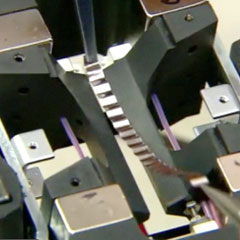
Making Records in the Desert
Wednesday, August 20th, 2008 | by matthew mcglynn
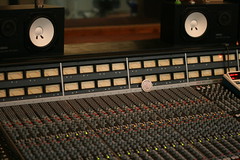 Stepbridge Studios has been a landmark of the Santa Fe recording scene for over 20 years. Founded by Tim Stroh in 1985 and in its current location since 1992, the studio provides the best gear and probably the best tracking room in the Southwest. The console is a 40-track SSL 4000 series, augmented by a vintage Neve BCM-10 “sidecar,” and the mic collection reads like a Neumann catalog. Well, actually, like a Neumann, AKG, and Gefell catalog.
Stepbridge Studios has been a landmark of the Santa Fe recording scene for over 20 years. Founded by Tim Stroh in 1985 and in its current location since 1992, the studio provides the best gear and probably the best tracking room in the Southwest. The console is a 40-track SSL 4000 series, augmented by a vintage Neve BCM-10 “sidecar,” and the mic collection reads like a Neumann catalog. Well, actually, like a Neumann, AKG, and Gefell catalog.
Stroh held the sound of the facility in high regard. He hired expert acoustic analyst Bob Hodas to tune up the control room, and gave him free reign to mock up various potential treatments on site — an unusual case, according to Hodas, and one that demonstrates Stroh’s commitment to squeezing the highest possible fidelity out of his studio. Acoustic architect George Newburn of Studio 440 was brought into the project for additional consulting.
 Stroh sold Stepbridge to a pair of fellow Santa Fe studio operators, Edgard Rivera (pictured at right) and Andrew Click of Rancho Digital, just a few years ago. Rivera and Click have been upgrading the facility, restoring mics and gear, and building out an impressive ADR and audio-post business.
Stroh sold Stepbridge to a pair of fellow Santa Fe studio operators, Edgard Rivera (pictured at right) and Andrew Click of Rancho Digital, just a few years ago. Rivera and Click have been upgrading the facility, restoring mics and gear, and building out an impressive ADR and audio-post business.
I visited the studio last month, and had an opportunity to talk to Andrew Click, who in addition to co-owning the place is the chief engineer. He graciously took an hour to give me a tour of the place after a very late night mixing a film soundtrack, and opened the interview with a line that I’ve taken for the title of this piece — thanks, Andrew!
Is this thing on? (tap tap tap tap)
 Making records in the desert, take one.
Making records in the desert, take one.
You are Andrew Click.
I am Andrew Click.
You’ve worked all over.
Pretty much. Cut my teeth in Los Angeles, spent some years out there. Went to a couple different audio schools out there. Got really tired of the traffic. I grew up in a little ski town in northern Utah, Park City, so after several years of dealing with the antics of a large city, it just wasn’t as pleasing as it used to be. I came to Santa Fe as a consultant on a six-month contract to build a studio for someone, and by the time that span was done, I think I spent about ten days [back] in Studio City before I had everything packed up in a U-Haul. It was a very sudden, very certain kind of decision. Since then, I’ve been working as an independent engineer/producer. About two years ago we bought this facility that you’re in now, Stepbridge. It’s been here for 22 years, but we basically just got lucky. Right place, right time — begged, stole and borrowed everything we could to get this place, and we did. It almost turned into three condos.
Oh no!
Yeah, it would have been really sad. We couldn’t let that happen. We bought it as a turn-key operation. We got really lucky. The old owner basically just was fried; he didn’t want the long nights, didn’t want the long days.
Good studios seem to stay pretty busy.
We’re lucky; we’re real busy. We feel very, very fortunate. We have so many national bands and signed bands, signed artists, labels come through here, as well as two-thirds of the upper echelon of the local music community. There’s always something going on. I’m really not a name dropper, but we’ve made Randy Travis’ last six records in here. We’ve had a whole bunch of movie people in here, just because we do so much looping. This place is a well-greased bread oven, I mean it just goes and goes and goes. We were lucky enough when we got this place to get the good faith of the business as well, which means we got a 20-year database of loyal, happy clients.
And the studio had a good reputation when you took over.
We’ve upped the bar since then, actually. A lot of people are really astounded at how the upgrades have taken place, how just the overall vibe in the studio is, how the gear has been maintained. We flew out one of the SSL techs for a week, and he gave me a beautiful crash-course. I’d done a lot of SSL maintenance over the years, just by being around these desks for so long. But if you’re around at 3:30 in the morning and something breaks, you have two options: you either stop working, or you fix it.
I take it you’re good with a soldering iron?
Yeah, by force, over the years, for sure (laughter). But that was one of our main goals when we got this place, was just to make sure that everything was just absolutely beautiful here. In the realm of microphones, we’ve gotten a few capsules from Germany that were long overdue. I had to rebuild some old power supplies, again, long overdue. Did our very best to get identical parts, matched parts, all the way across the circuit boards, which we did.
While we’re on the subject, tell me more about the gear.
 We have an entire rack of Pultecs from the 1960s; those have an incredibly unique, very very warm, lush sound. [We have] LA2s, before they even put the ‘A’ on, within the first fifteen hundred that were ever made. I think those were 1958 if I remember right. A slew of different Neve pre’s, we have 1066s, we have 1272s, we have the Brent Averill knockoffs of the 1272s. We have V-72s that were pre-Neumann Telefunkens, and then of course the SSL pre’s if we start running out.
We have an entire rack of Pultecs from the 1960s; those have an incredibly unique, very very warm, lush sound. [We have] LA2s, before they even put the ‘A’ on, within the first fifteen hundred that were ever made. I think those were 1958 if I remember right. A slew of different Neve pre’s, we have 1066s, we have 1272s, we have the Brent Averill knockoffs of the 1272s. We have V-72s that were pre-Neumann Telefunkens, and then of course the SSL pre’s if we start running out.
I tend to try to goop stuff up while we’re tracking, with the Neves and the tubes, simply because the 4000Gs EQs are very precise, and they’re bright.
So I think it’s a perfect, perfect combination of gear, using almost all Neve, vintage Pultecs, vintage tube stuff generally on the way into Pro Tools, capturing it at a real high sample rate, typically mixing through the SSL and those circuits after the fact.
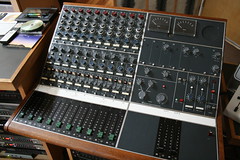 There’s the 1971 Neve [BCM-10]. That thing is a treasure. I mean, it’s really one of the most gentle consoles I’ve ever used. It’s just beautiful for tracking rhythm sections, drum, bass. It’s amazing. Acoustic guitars as well. And then from there, we have a slew of old amps. We have a B3 that works beautifully, we have a Wurlitzer that’s just been gutted and put back together a couple years ago. Got a Rhodes that made it through a church fire intact. So pretty much all the classic, classic instruments for making music are here, in house, basically available to anybody who wants to use them.
There’s the 1971 Neve [BCM-10]. That thing is a treasure. I mean, it’s really one of the most gentle consoles I’ve ever used. It’s just beautiful for tracking rhythm sections, drum, bass. It’s amazing. Acoustic guitars as well. And then from there, we have a slew of old amps. We have a B3 that works beautifully, we have a Wurlitzer that’s just been gutted and put back together a couple years ago. Got a Rhodes that made it through a church fire intact. So pretty much all the classic, classic instruments for making music are here, in house, basically available to anybody who wants to use them.
Studio A is very well set up to do music — ensemble tracking. On our other side we have a pretty much dedicated post-production room. We have a flat-screen in there, do a lot of looping, do a lot of blocked pictures, sync-oriented stuff, a lot of voice-overs. There are enough, how would you say, not “celebrities,” but people with name and credibility, you know, famous people, scientists, as well as the movie stars, the rock stars —
Doing voice overs?
Yeah, they all live here in Santa Fe; you’d be really surprised how many people with huge names actually live here. Most everyone comes to us when they need something, because it sure beats getting on a plane and going to LA for a day. That’s really a huge selling point for us, because we have basically everything that any studio in LA would have, but we’re right around the corner.
So the ADR room is booked with radio and movie stars. What’s the client list for Studio A — all signed bands?
$120,000 of vintage mics, a million and a half dollars’ worth of gear — it’s real easy to make things sound good.
It’s a really interesting mix, I’ll say that. There are probably a hundred home studios around here. Some of them are nicer than others. The big sell point that Edgard and I have come across is that bands end up spending so many extra hours in an unstable studio environment, something like a bedroom studio or a garage studio, that we’ve actually gone penny for penny on projects, just to see. We figured out that in the time it takes us to just bang out a quick record for a local band — I think we said it was a block and a half of time, which is a day and a half, $1500 or so. That’s not the best work ever, but it sounds great. And we’ve looked at the home studio angle, and even at $20 or $25/hour, they spend an entire day just trying to get their drum sounds. And most home studios don’t have HD so they’re stuck with fewer inputs, and in the time it takes, it really equals out.
The engineering staff here is bar none the best around. $120,000 of vintage mics, a million and a half dollars’ worth of gear — it’s real easy to make things sound good. We have enough iso booths and enough space that we can get the full band tracking at the same time. Even though they’re spending more by the hour, they spend about a third of the time.
The other big factor, I would think, is the room. A great tracking room is something that no home studio would have.
Exactly. A good ninety-five percent of the home studios — I mean, they work. They absolutely work, and it’s just a matter of where you want the quality to lie, where you want to set the bar of excellence. And we set it real high here.
 By the way, what the heck happened to this microphone?
By the way, what the heck happened to this microphone?
That was a Gefell UM70. A rock band got to that one, the capsule actually burst. That’s the only time I’ve ever seen that. It just exploded.
You mentioned doing voice-over work. It seems that many of the other studio owners I’ve met seem to fall into two camps: “Well, we had to start taking voice-over clients.” Or, they say “No, we refuse to start taking voice-over clients… so we’re sort of not working as much as we used to.” (laughter)
Anything to do with film these days is ridiculously good money, it really is. I mean, we can work for a couple hours in a looping session and make more than this music studio does in a full day, hands down.
Is that due to film budgets being bigger, so they’re just accustomed to paying higher fees?
Yes, and they also have a very very high level of quality control. So again, they don’t mind paying the higher fees to assure that their talent is going to get in and get out, and not get trapped, not have to come back for re-do’s. That’s all really huge when you’re talking about a $10 million dollar per contract actor.
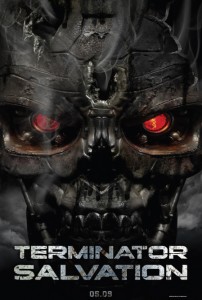 The money gets astronomical on some of those productions. Terminator 4 is being filmed here now. I think it is the largest film to be done in New Mexico, and it’s $500-plus million.
The money gets astronomical on some of those productions. Terminator 4 is being filmed here now. I think it is the largest film to be done in New Mexico, and it’s $500-plus million.
Will you see any of that business?
They’re still filming it, so any post-production is probably yet to be seen for another month or so. This is totally off the subject — I heard they were dropping tanks out of airplanes in the desert for this movie. They were doing some sort of post-nuclear-fallout shot. And so they had literally found all these decommissioned tanks and Army tools, big huge trucks and things, and they’d drop them out of an airplane at 10,000 feet.
And were they filming the impact?
No, no, just to create the space to do the scene. I mean, that’s how much money they had. They painted 50 acres red, for some reason.
How do you paint 50 acres red?
With paint. Spray paint I guess, I don’t know. (laughter) But yeah, they found somebody that was crazy enough to say yes, and they painted his entire ranch red.
The trickle down that’s coming here from LA is hilarious, in the sense that I moved out here to get away from LA, and all of a sudden within the past couple years LA is here. It is here. We have some huge sound stages in the state now. We’re actually doing more filming in New Mexico than California is. It trickles down in all different facets. The hotels are booming, the restaurants are booming, all of the limo and transportation companies are booming. We’re booming, simply because we do, not a whole bunch of audio post, but enough. If we were just doing music in this facility, I think we’d probably have a similar story, about every other studio in Los Angeles county, for example, “yeah, we’re working, but it’s just not paying the bills!” A couple looping sessions a month and our bills are paid. So we can be creative in here, instead of having to whore out the studio.
Just to paint a picture, your ‘A’ studio has a big live room, a couple iso booths, and a big analog console. What’s the profile of the ‘B’ studio?
It’s a beautifully set up voice-over room. That means the tracking booth is tight and dead — lots of acoustic treatment, lots of wall treatment. The gear list is pretty straightforward. There are a couple 1272s, but mostly it’s just Focusrite and Digidesign stuff. End of story, it’s a real simple setup. But that, in the voice-over and film world, is exactly what people want. They don’t want any tonal coloration, they don’t want any compression, they don’t want anything, because it wouldn’t match all of their other source audio once they go to actually sit down and actually mix everything.
Do you decide on the input chain, or does that come from the film studio?
Usually it’s the ADR supervisor or sound supervisor. They’ll send ahead what is called a spec sheet, which is their wish list: this sample rate, this drop-frame, this pull-down, time code starting here, this mic, this pre. We always do our very best to cater to what they’re looking for.
As a mixer, I completely understand trying to get vocals, especially word-for-word lines, to line up when somebody’s using a whole barrage of gainstage, and half of it is really heavily colored circuits. If you try to compare that with the next line that was recorded with a boom mike on location, it’s impossible … I mean, it’s not impossible, but you’re spending an hour and a half trying to tone out that line so it matches, and meanwhile you have another ninety minutes to go (laughter). I really enjoy film mixing, quite honestly, because it’s very intense. There’s so much to pay attention to, but it’s super fun because of it.
In this room, Studio A, do you more typically record digitally or to tape?
We do both, but economically speaking, a reel of tape that lasts fifteen minutes is about $350 these days. So to get a whole record on tape you’re looking at probably $1500, just in tape costs. And then, if you want to be a purist, and keep quarter-inch going the whole time you’re printing mixes, then it’s another $1000. So to answer your question, much to my dismay as an audiophile, we do a lot more hard disk recording than I would like. (laughter)
Do you sometimes track to tape, then pull the audio into Pro Tools afterwards for editing?
Tape is unstable media — just glue, Mylar, and rust.
We do that sometimes, but we don’t have studio reels up for grabs. I really try to push people into getting a least a reel of tape. Because then, track by track, you can easily get two, three takes of a song on a reel of tape. Make sure it’s proper, make sure we have the right take, dump that into Tools, and then track the next one. And then track the next one, and then track the next one. But, at the same time, tape being tape, and it is unstable media — being just glue, Mylar, and rust — every time you record something to that oxide, it’s going to be that much less susceptible to being magnetized again. So you’re going to degrade your sound quality literally every track you go. By the twelfth song, you’re going to be hearing a difference for sure. And in this economic day of woe, nobody wants to drop the extra $2000. To them, studio time, the gas to get here, feeding the band and all that, is plenty expensive.
Plus, I hate to say it, there’s a lack of efficiency that tape brings. You actually have to wait for things to rewind. You actually have to get punch-ins right, or do them again.
I grew up with a computer in my face almost my whole life, and I’ve become so impatient, just because technology has gotten so good. I mean, after cutting five or ten records in a row, in Pro Tools, and getting all the group edits, tuning, so on and so forth, dealt with, then to go back to some purist jazz recordings… for example, just a while ago, a jazz four-piece came in, saying “Sorry, we’re old-school, you need to roll tape, or we’re not doing it.” And I was like, “Yeah! Let’s do it!” So we ordered up some tape, and by the time we were actually done rolling all of the tracks, they wanted me to put it all in Pro Tools — so that we could just mix it in Pro Tools.
And the next time they come in they won’t even ask for tape.
Or maybe, just for drums and bass.
Did that record get mixed to tape?
Yeah, mixed to quarter-inch, and then back in [to Pro Tools] at 24 [bit]/192 [kHz]. And then mastered digitally, so I think it was, all in all a good process. It was a little bit more consuming, length and time-wise, than most.
“That sucked. Come on in; we can fix it.”
But, I hate to say this, the average consumer — someone that would buy what used to be a “record” — now they’re buying MP3s. And a good 90% of those people are listening on in-ear monitors, on headphones. So the translation of getting stuff to feel good in a room is almost being overlooked by a lot of the youngsters these days. The quality for recording to me has gone down so much, in all facets — in engineering, in playing, in musicianship, all of the above — because they all know that Pro Tools exists now: “That sucked. Come on in; we can fix it.” Instead of back in the day, if it was Billie Holiday, or one of those cats, it had to be right or everybody was going back in there because there were only three mics in the room anyway. That, to me, was actually making records, and people cared, and man, could they play.
And now, look at Britney Spears, just for example. I know a guy in LA, bless his soul, he has a full-time job tuning her voice, seven days a week. That kind of says where the entire industry is going.
Isn’t there a plug-in for that?
There is, but someone has to drive the train. There’s a lot more detail to be had if you actually, syllable by syllable, go in and graph the pitch, instead of just saying “auto tune.” So that’s one of my major qualms with the industry, but what can you do but roll with it? I mean, it’s always so heart-wrenching to me to be mastering something in 24/192 or off of tape through a whole bunch of gear, and then hear it as a medium-res MP3 later. You know what I mean: “Oh my God, what happened?”
 On that depressing note, Andrew took me into the live room to cheer us both up. It’s a gorgeous 25′ x 33′ x 16′ space, with over a dozen mint-condition vintage mics mounted on stands for easy access, covered in Crown Royal bags to help protect the capsules from dust. I didn’t happen to have my drum kit with me, so I didn’t get to track anything, but I wanted to. The space felt great. Voices had a nice resonance without sounding boomy or echo-y. Bob Hodas had a hand in tuning the room, back in 1999-2000.
On that depressing note, Andrew took me into the live room to cheer us both up. It’s a gorgeous 25′ x 33′ x 16′ space, with over a dozen mint-condition vintage mics mounted on stands for easy access, covered in Crown Royal bags to help protect the capsules from dust. I didn’t happen to have my drum kit with me, so I didn’t get to track anything, but I wanted to. The space felt great. Voices had a nice resonance without sounding boomy or echo-y. Bob Hodas had a hand in tuning the room, back in 1999-2000.
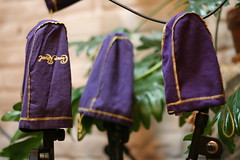 I can’t take credit for all the Crown Royal bottles, those were the old guy’s. (laughter) But they certainly do make good microphone covers. We’re in the area of microparticles out here. It’s in the air, all the time, coming in no matter how many filters we have on our A/C. We do our best to keep them clean.
I can’t take credit for all the Crown Royal bottles, those were the old guy’s. (laughter) But they certainly do make good microphone covers. We’re in the area of microparticles out here. It’s in the air, all the time, coming in no matter how many filters we have on our A/C. We do our best to keep them clean.
Besides the sand blowing in the door, does being in the desert affect other aspects of the recording process?
Everything is constantly changing, even just the environment. Depending on what the air pressure and humidity are doing here — because it’s the desert, it changes quick and it changes vastly. Something that sounded great one day will sound like shit another.
Do you mean the instruments are changing?
Guitars bend because it gets so dry. Necks warp. Things get tweaked. Intonation just gets screwed. Drum hardware squeaks. All the way down to air density in the room — I know people who really like tracking at high elevation because the high frequencies pass further. There’s less oxygen in the air, less density. I have a friend that has a studio at just under 10,000 feet in southern Colorado, and some of the best acoustic guitar tracks I think that I’ve ever recorded happened there. For that reason. It wasn’t a special microphone, it wasn’t a special pre, wasn’t a special guitar. But it sounded so good. And it was ridiculous how it translated.
I’m kind of a physics buff — I really lean a lot on the practical side of engineering. Like what actually is proven, instead of just guessing with an EQ or something. I’d rather isolate exactly what it is, and deal with a mix that way. If you approach a mix with math in your mind it’s so much easier to get issues out of the way.
For example, a full salsa ensemble, with five horns, upright bass, huge drummer or percussionist, two or three singers, the whole spread — ten, twelve people in the band. A lot of frequencies will mish-mash over each other. The bottom end of a tenor sax is going to be right where the midrange of a guitar is, which is right where the upper end of a bass is, which is right near the bottom of the where the snare’s gonna be.
What do you do?
Well, approach it mathematically. You start EQ-ing your ass off. That’s what I do. (laughter)
You’ve said you’re busy, and the local economy seems healthy, but have you seen evidence of a slowdown? How many days a month are you booked?
Sometimes I won’t get a day off for two, three months. And other days, or other months, we’ll be about half booked. We’re still doing a lot of commercial work, but the local music has really trickled back this year. My belief is that the people that used to have $5000, $1000 extra a year, because they were working hard — electricians, carpenters, the guys who make up the average bar/rock band — they would come in, split the bill four ways with their band, and make a really nice record once a year, just like clockwork. These guys are, this year, not able to do it. Because nobody’s building, nobody’s buying, nobody’s remodeling. Gas is eighteen dollars a gallon. On and on and on. I have a lot of people drive up here for sessions, just from Albuquerque, and that’s 60 miles. But in terms of gas, if they’re bringing up a truck with a trailer full of gear, that’s $150, just to get here.
But I don’t think this place is going anywhere. Edgard and I have too much love for this space itself. We’d rather lose our houses than lose this place. Have a tent pitched up on the roof or something if I had to.
Well an iso booth sleeps two, so … (laughter)
Yeah, totally.
While the number of local recording clients declines, you mentioned you’re seeing a rise in European clients?
This city is really smart. They’ve been gearing it towards family, so it really makes a lot of sense for someone, for example, from Paris, to come out here for a month, and bring their entire family so they don’t get in trouble when they’re not at home for a month. Park the family in town with activities, things to do, while they’re here, working on a record during the day and hanging out with their fam at night.
And it’s probably cheaper for them to be in Santa Fe, than in LA.
Yeah, and again, it’s even cheaper, because the Euro is kicking the American dollar’s butt. So they’re almost getting two to one, for everything they’re doing out here.
And at that point it was time to take one last, longing look at the studio’s 1961 U47 and the 1960 M249, not to mention the consoles and racks of gear, then beat it back to the plaza where kick-ass live music seems to happen every night.
View the full set of Stepbridge Studios photos.
My Fall travel calendar includes LA, Las Vegas, Chicago, Dublin, and the west coast of Ireland, so if you’d like to recommend a studio for me to visit, please get in touch.
Tags: andrew click, bob hodas, edgard rivera, george newburn, recording studios, santa fe, stepbridge
Posted in Interviews, Studios, Travel | No Comments »

